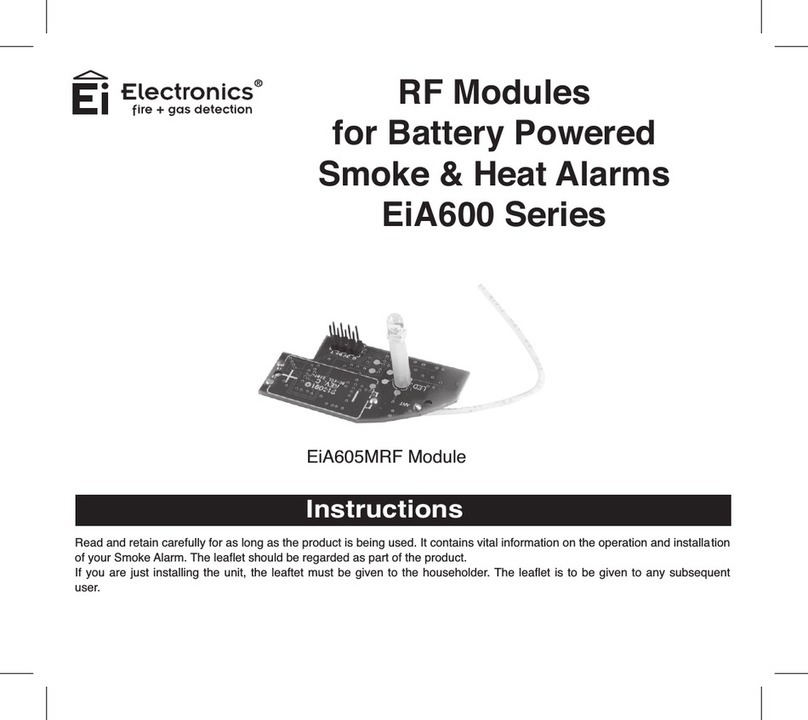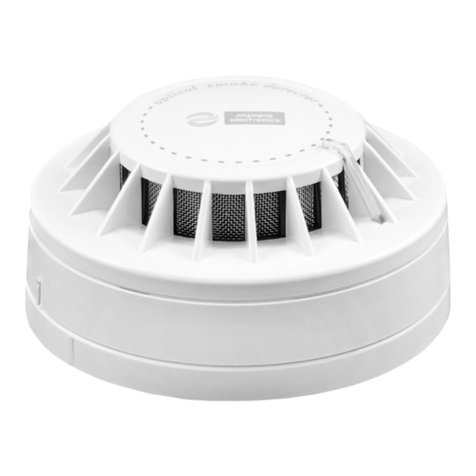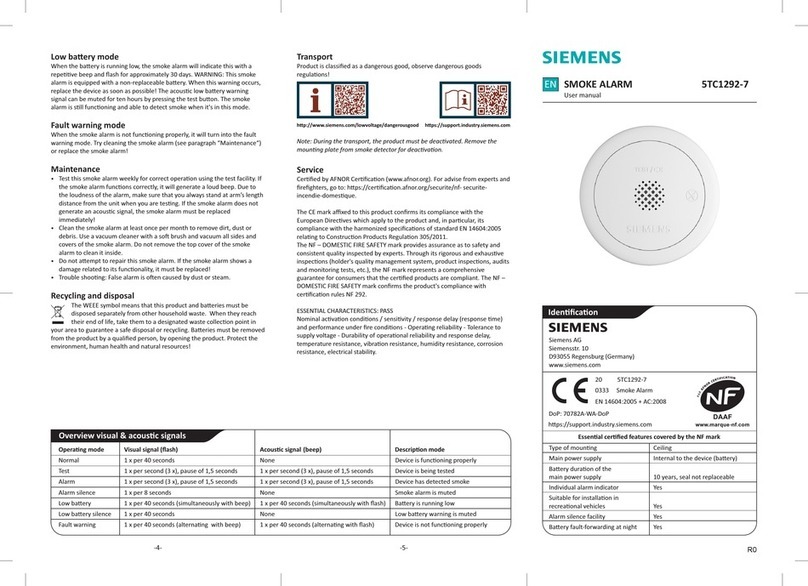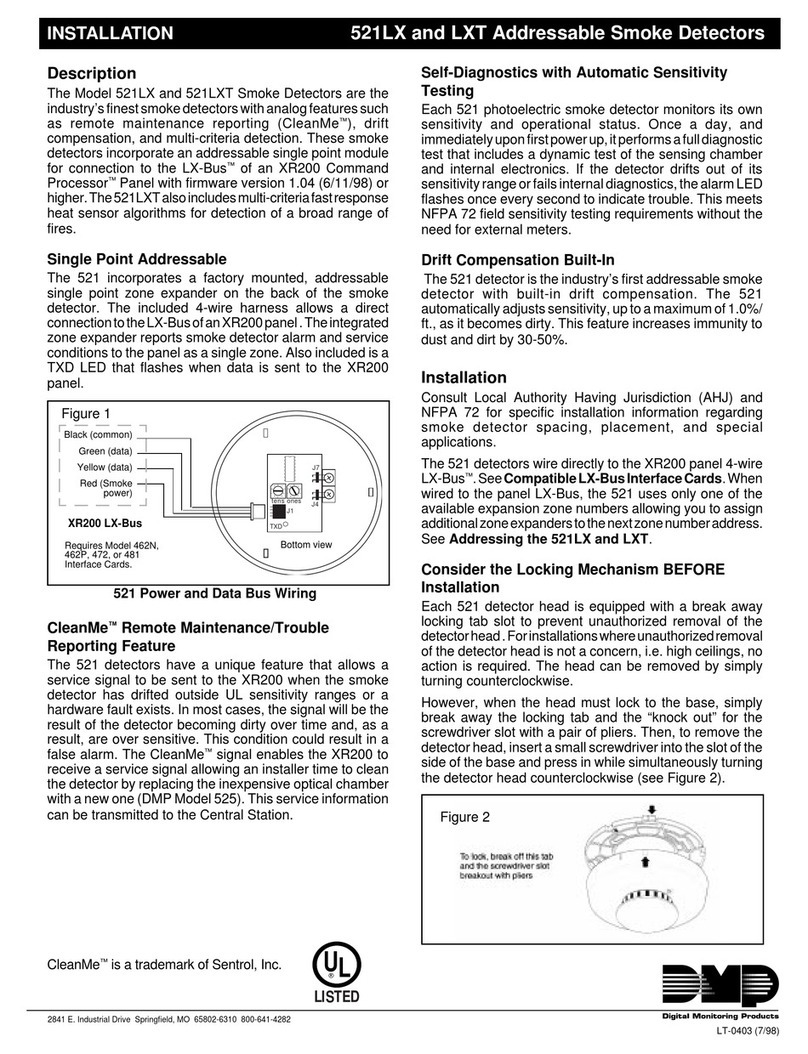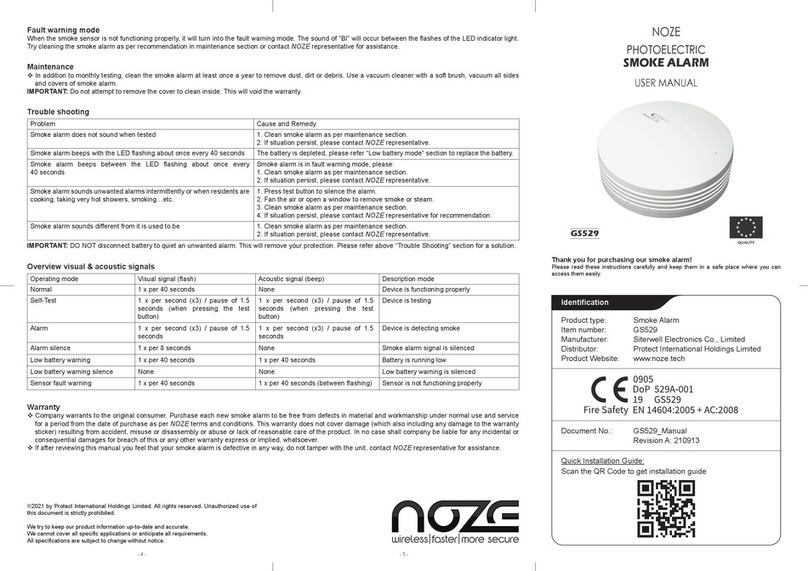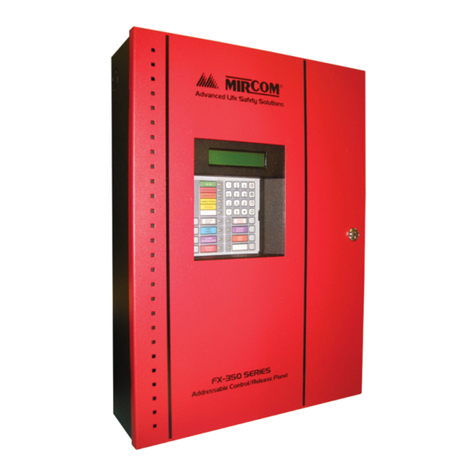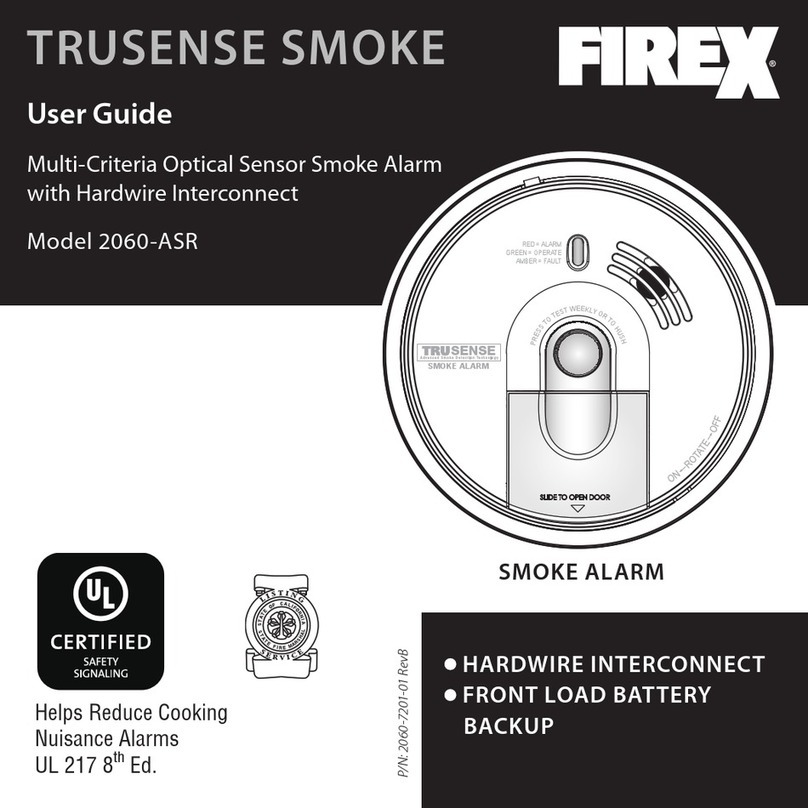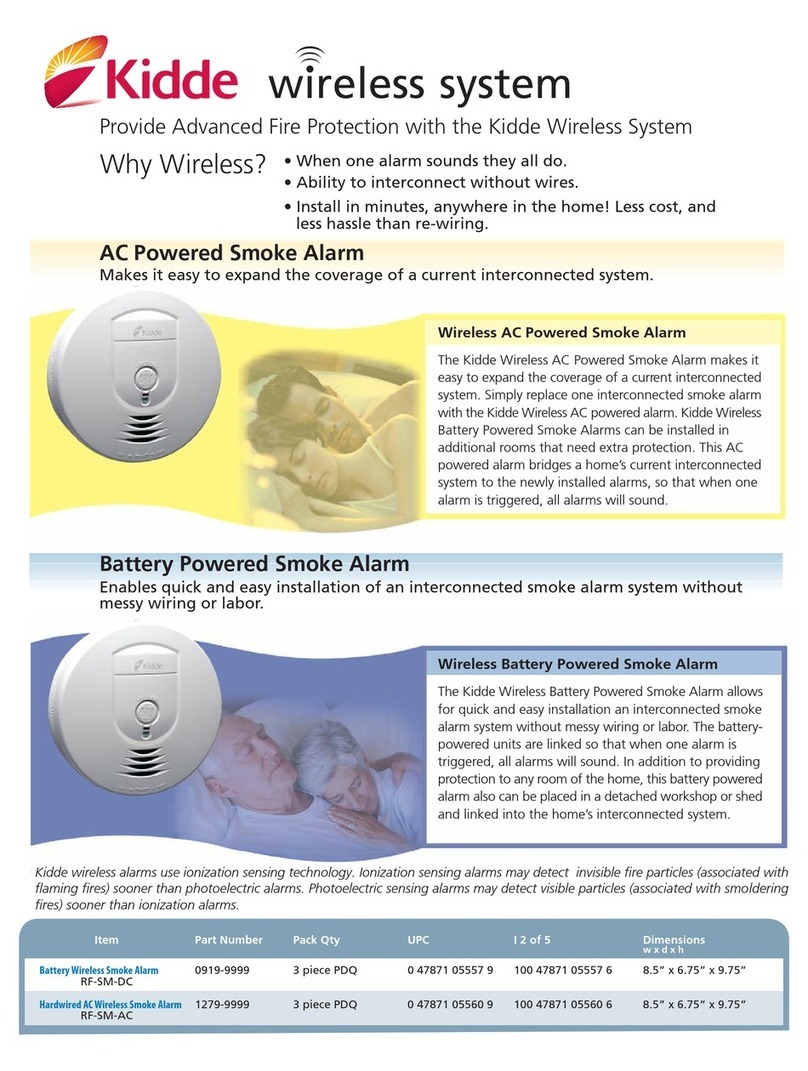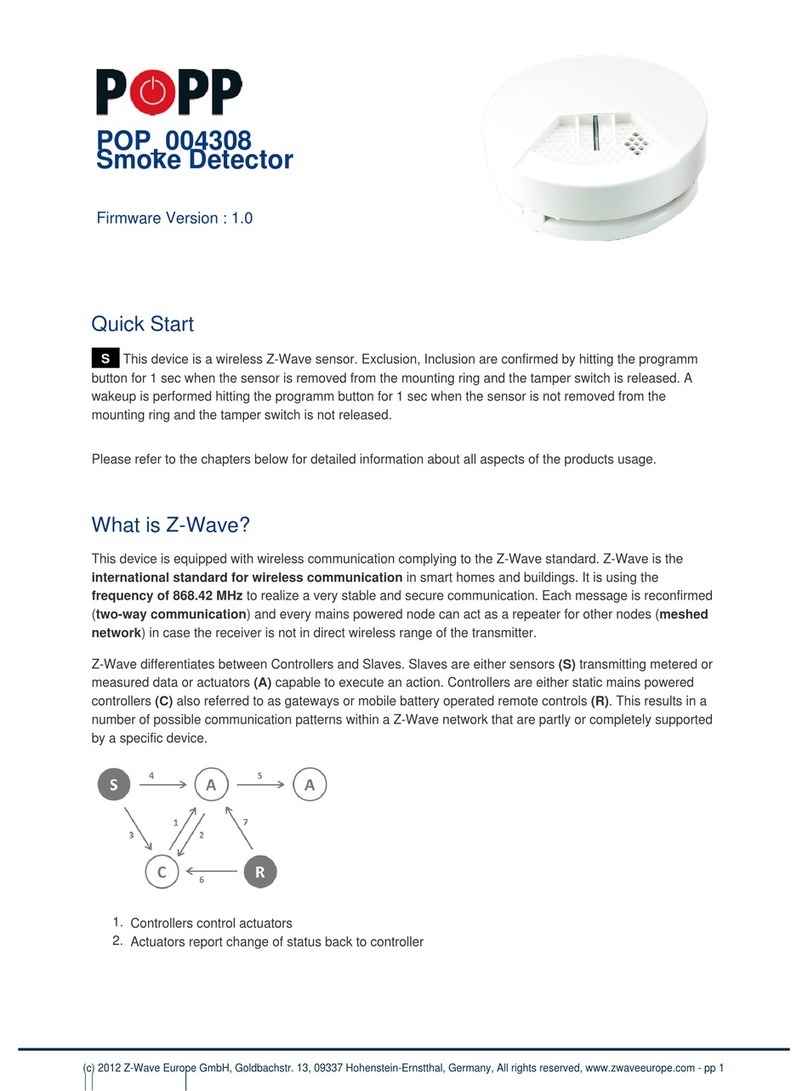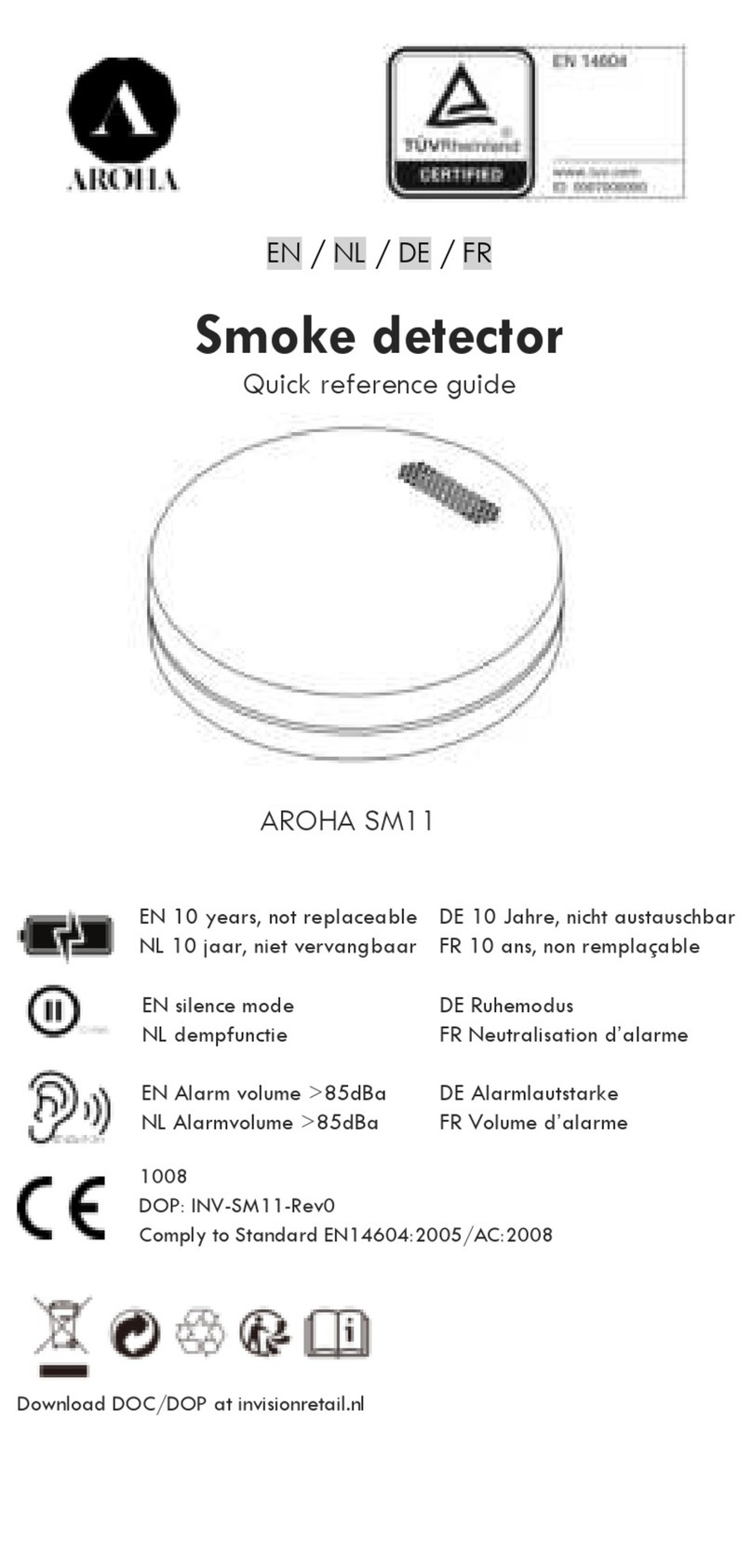Nittan EVC-PY-IS User manual

NITTAN EUROPE LTD. Hipley Street, Old Woking, Surrey, England, GU22 9LQ. UK
Tel: +44 (0) 1483 769555 • Fax: +44 (0) 1483 756686
EVCPYIS
Conventional
Intrinsically Safe
Photoelectric
Smoke Detector
instruction manual
Quality System Certificate No. 041
Assessed to BS EN ISO 9001
• Ref No: NISM/EVC-PY-IS/02 • 19.02.19 • Issue: 2
• Evolution • EVC-PY-IS • Conventional Intrinsically-Safe Photoelectric Smoke Detector instruction manual

Manual: EVC-PY-IS Manual 000027 (Changes are subject to DCRN)
2
• Ref No: NISM/EVC-PY-IS/02 • 19.02.19 • Issue: 2
• Evolution • EVC-PY-IS • Conventional Intrinsically-Safe Photoelectric Smoke Detector
evolution.....
The EVC-PY-IS Intrinsically-Safe Photoelectric Smoke Detector forms part
of a range of fire detectors from Nittan Europe Ltd. called evolution.
The EVC-PY-IS is an elegantly designed, low profile detector which is
aesthetically pleasing, thus enabling it to blend unobtrusively into modern
working environments.
The EVC-PY-IS is compatible with other existing conventional fire
detection systems, but is intended for use in Hazardous Areas, with the
relevant Isolator barrier.

Manual: EVC-PY-IS Manual 000027 (Changes are subject to DCRN)
CONTENTS:-
Section 1
Introduction Page 3
Section 2
Operation Page 3
Section 3
Detector Models Page 3
Section 4
Base Models Page 4
Section 5
Instalation Page 4
Section 6
Maintenance & Page 5
Cleaning
Section 7
Specifications Page 7
Section 8
Environmental
Parameters: Page 7
- Temperature Page 7
- Humidity Page 7
Section 9
Compatible Barriers Page 8
Section 10
EMC Page 8
Section 11
Connections Page 9
Section 12
Dimensions Page 9
Section 13
Disposal Page 10
Section 14
ROHS Compliance
Statement Page 10
3
• Ref No: NISM/EVC-PY-IS/02 • 19.02.19 • Issue: 2
• Evolution • EVC-PY-IS • Conventional Intrinsically-Safe Photoelectric Smoke Detector
Section 1 - INTRODUCTION
The EVC-PY-IS is an attractively-styled, low profile photoelectric smoke
detector for use in conventional fire detection systems.
The EVC-PY-IS has a chemically etched, stainless steel insect screen therefore
reducing the ingress of insects and airborne contaminants.
EVC-PY-IS features:
* Optical detector, detecting visible particles of combustion
* Low profile, stylish appearance
* Supplied with protective dust cover (remove during commissioning)
* Non-polarised terminals
* Unauthorised head removal signal facility
* Low monitoring current
* OMNIVIEW™ 360° LED fire alarm indicator
* Remote indicator output* Compatible with STB-4-IS and
UB-4-IS bases
Section 2 - EVC-PY-IS
The smoke chamber of the EVC-PY-IS is constructed so that light cannot enter
from outside, but smoke can pass through the chamber slots. The EVC-PY-IS
utilizes the light scatter sensing principle. An alarm condition is verified before
an alarm is given.
The detector design provides strong immunity to air velocities, contamination
and RF interference.
The geometry of the smoke chamber and optics support assembly is designed
to give the best possible signal to noise ratio, resulting in excellent response
characteristics.
Section 3 - DETECTOR MODELS
The EVC-PY-IS photoelectric smoke detector is supplied, as standard, with
four terminals.
The EVC-PY-IS has the facility to activate a remote LED indicator or auxiliary
function, as standard.
The terminals on the EVC-PY-IS detector head are configured as follows:-
Terminal 2 = zone positive in/out
Terminal 1 = zone negative in
Terminal 6 = zone negative out
Terminal 5 = 2mA @ 24V d.c. switched output

Manual: EVC-PY-IS Manual 000027 (Changes are subject to DCRN)
4
• Ref No: NISM/EVC-PY-IS/02 • 19.02.19 • Issue: 2
• Evolution • EVC-PY-IS • Conventional Intrinsically-Safe Photoelectric Smoke Detector
Section 4 - BASE MODELS
It is important to use the correct base for the EVC-PY-IS intrinsically-safe
smoke detector.
The UB-4-IS base is designed exclusively for use with EVC-PY-IS detector;
this base has 4 terminals including an auxiliary output function.
The STB-4-IS base is mechanically and electrically compatible with the EVC-
PY-IS detector and may be used as an alternative.
Section 5 - INSTALATION
In normal use, the EVC-PY-IS detector will be installed at ceiling level.
Pass the field wiring through the cable hole in the centre and from the rear
of the base. Offer up and affix the base to the ceiling or conduit fitting with
screws via the base mounting holes. Connect the field wiring to the base
terminals, as detailed on page 6 making sure the wiring does not obstruct
fitting of the detector head. Fit the detector head by inserting it into the
base and turning clockwise until the notch in the detector rim aligns with
base locking screw. The OMNIVIEWTM 360° indicator permits visibility
from any angle.
Fit the plastic dust cover supplied over the detector to keep out dust
etc, until the system is commissioned. If the dust cover is not fitted and
the environment is slightly dusty, such as when building work is being
completed, for example, problems of false alarms are likely to occur
after commissioning unless cleaning of the detector is undertaken. At
commissioning, the dust cover should be removed and discarded.
Note: The plastic dust cover must be removed from the detector
inorder for the detector to function correctly.

Manual: EVC-PY-IS Manual 000027 (Changes are subject to DCRN)
5
• Ref No: NISM/EVC-PY-IS/02 • 19.02.19 • Issue: 2
• Evolution • EVC-PY-IS • Conventional Intrinsically-Safe Photoelectric Smoke Detector
Section 6 - MAINTENANCE AND
CLEANING
Maintenance:
The EVC-PY-IS detector is a high quality product engineered for reliability. In
order to obtain optimum performance, periodic maintenance is required. If
proper preventative maintenance is not carried out, there is a likelihood of
malfunction, as a dirty detector is more likely to cause a false alarm.
Servicing:
Servicing of the system should be carried out in accordance with the
requirements of BS 5839 Part 1, Fire Detection and Alarm Systems
for Buildings: Code of Practice for System Design, Installation
and Servicing.
The maintenance procedures described below should be conducted with the
following frequency:
One month after installation: Routine Inspection and every 3
months after.
Every 6 months: Operational Test.
Every 12 months: Functional Test and Clean.
All above frequencies of maintenance are dependent on
ambient conditions.
Routine Inspection
i) Ensure the sensor head is secure and undamaged.
ii) Check the smoke entry apertures are in no way obstructed.
iii) Ensure the surface of the detector’s outer cover is clean. If there
are deposits due to the presence of oil vapour, dust etc, then the
detector should be cleaned in accordance with the cleaning
instructions detailed later in this manual. It may be advisable to
ensure that such cleaning is conducted regularly in the future.
iv) Ensure no equipment which may generate combustion products or
fine airborne particles, has been installed in the vicinity of the
detector since the last routine inspection. If such equipment has
been installed, then you should notify the Fire Safety Officer or
other competent authority that its presence may cause false alarms.

Manual: EVC-PY-IS Manual 000027 (Changes are subject to DCRN)
6
• Ref No: NISM/EVC-PY-IS/02 • 19.02.19 • Issue: 2
• Evolution • EVC-PY-IS • Conventional Intrinsically-Safe Photoelectric Smoke Detector
Operational Test
The purpose of the Operational Test is to confirm the detector’s correct
operation in response to a smoke condition.
i) Take any necessary precautions at the control panel to limit the sounding
of the alarm sounders/bells and any fire service summoning device.
ii) Introduce a discrete amount of smoke into the detector head, e.g. using
a ‘No Climb-Solo’ smoke test head. Check that the detector gives an
alarm condition within 15 seconds. Check the LED indicator on the
EVC-PY-IS detector illuminates and any remote indicator LED fitted also
illuminates.
iii) After the detector has given the alarm condition, reset the detector from
the control panel. It may be necessary to allow a short time to elapse
before resetting the detector, to allow any residual smoke from the test to
disperse.
iv) Before proceeding to the next detector, ensure that the
detector just tested does not re-operate due to the presence of
residual smoke.
Functional Tests:
The detector may be returned to Nittan Europe Ltd for functional testing.
Cleaning:
Note: The detector head should NOT be disassembled.
i) Carefully remove the detector head from its base.
ii) Use a soft, lint-free cloth, moistened with alcohol for sticky deposits, to
clean the plastic casing.
iii) Using a soft bristle brush (e.g. an artist’s paint- brush) carefully brush
between the vanes in a linear motion away from the smoke entry
apertures.
iv) It is permissible to blow dust from the chamber, without removing the
cover, using a clean air line.
v) If the unit needs further cleaning, or is damaged or corroded, please
return the compl
ete detector to Nittan Europe Ltd. for service.

Manual: EVC-PY-IS Manual 000027 (Changes are subject to DCRN)
7
• Ref No: NISM/EVC-PY-IS/02 • 19.02.19 • Issue: 2
• Evolution • EVC-PY-IS • Conventional Intrinsically-Safe Photoelectric Smoke Detector
Section 7 - SPECIFICATIONS
Model Reference: - EVC-PY-IS
Part Number: - F02N83300
Detector Type: - Photoelectric smoke detector
Sensitivity - 4.5% Obscuration per metre
Supply Voltage: - Limited to 28V dc by intrinsically-safe barrier
(range 10V to 32V)
Voltage Ripple: - 20% maximum
Alarm Characteristics: - 6V d.c. in series with 100R between
+(terminal 2) and (terminals 1,6) at 25°C
Monitoring Current: - 50µA max. at 24V dc
Alarm Current: - <50mA (limited by intrinsically-
safe barrier)
Charging Time: - 1 Minute
Ambient Temperature - -10°C to +50°C (Limited by
Range: ATEX requirements)
Standard: - EN54-7:2000
EMC Conformance: - BS EN50130-4:1996 (Immunity)
ATEX Certification - ITS09ATEX26418X
Ga Ex ia IIC T4, Ta = 50°C
CPD Certification - 0786-CPD-20883
Mass: - 110g (excluding base)
IP Rating: - 42
Certified to standard:
CE certificate: - TBA
Section 8 - ENVIRONMENTAL
PARAMETERS
Temperature Considerations:
Over the range from -10 ºC to +55 ºC
Humidity:
Relative Humidity of up to 95%, measured at 50 ºC,
non condensing.

Manual: EVC-PY-IS Manual 000027 (Changes are subject to DCRN)
8
• Ref No: NISM/EVC-PY-IS/02 • 19.02.19 • Issue: 2
• Evolution • EVC-PY-IS • Conventional Intrinsically-Safe Photoelectric Smoke Detector
Section 9 - COMPATIBLE BARRIERS
The following barriers are suitable for use with the EVC-PY-IS Intrinsically-
Safe Photoelectric Smoke Detector.
• MTL5061 2 channel fire and smoke detector interface
(BAS01ATEX7160)
• MTL4061 2 channel fire and smoke detector interface
(BAS01ATEX7176)
• Pepperl+Fuchs KFD0-CS-Ex1.54 1-channel isolated barrier
(BAS00ATEX7087X)
• Pepperl+Fuchs KFD0-CS-Ex2.54 2-channel isolated barrier
(BAS00ATEX7087X)
• Pepperl+Fuchs KFD0-CS-Ex1.51P 1-channel isolated barrier
(BAS98ATEX7343)
• Pepperl+Fuchs KFD0-CS-Ex2.52P 2-channel isolated barrier
(BAS98ATEX7343)
• Pepperl+Fuchs Z728.F 1-channel Zener barrier (BAS 00 ATEX 7096)
Section 10 - EMC
Installation
The installation shall be in accordance with the regulations either of the
approval body for an approved system, or otherwise, to the national code
of practice/regulations for the installation of the fire alarm system, e.g. BS
5839 part 1.
Electromagnetic Compatibility (EMC)
On a site where there is an unusually high level of potential electrical
interference, e.g. where heavy currents are being switched or where high
levels of R.F. are prevalent, care then must be taken in the type and routing
of cables. Particular care should be given to the separation of zone wiring
from the cable carrying the interference.

Manual: EVC-PY-IS Manual 000027 (Changes are subject to DCRN)
9
• Ref No: NISM/EVC-PY-IS/02 • 19.02.19 • Issue: 2
• Evolution • EVC-PY-IS • Conventional Intrinsically-Safe Photoelectric Smoke Detector
Section 12 - DIMENSIONS
If +ve supply derived from zone
then RIL must be LED type
+
3
RIL
3
1 5
1 5
6 6EOL
Max. current through
_
5 = 2mA @ 24V d.c.
RIL must be 6V, 2mA max.
15mm
33mm
104mm
Section 11 - CONNECTIONS

Manual: EVC-PY-IS Manual 000027 (Changes are subject to DCRN)
10
Section 13 - DISPOSAL
This symbol on the EVC-PY-IS indicates that this product must not be disposed
of with household waste. Instead, it is your responsibility to dispose of your
waste equipment by handing it over to a designated collection point for
the recycling of waste electrical and electronic equipment. The separate
collection and recycling of your waste equipment at the time of disposal will
help to conserve natural resources and ensure that it is recycled in a manner
that protects human health and the environment. For more information about
where you can drop off your waste equipment for recycling, please contact
your local city office or your household waste disposal service.
Section 14 - ROHS COMPLIANCE
STATEMENT
(RoHS compliant and lead-free)
This product complies with the European Union RoHS (Restriction of
Hazardous Substances) directive 2002/95/EC which restricts the use of
the following six hazardous materials in the manufacture of electronic and
electrical equipment.
• Lead (Pb)
• Hexavalant Chromium
• Mercury (Hg)
• Cadmium (Cd)
• Polybrominated biphenyls (PBB’s)
• Polybrominated diphenyl ethers (PBDE’s)
• Ref No: NISM/EVC-PY-IS/02 • 19.02.19 • Issue: 2
• Evolution • EVC-PY-IS • Conventional Intrinsically-Safe Photoelectric Smoke Detector
Table of contents
Other Nittan Smoke Alarm manuals
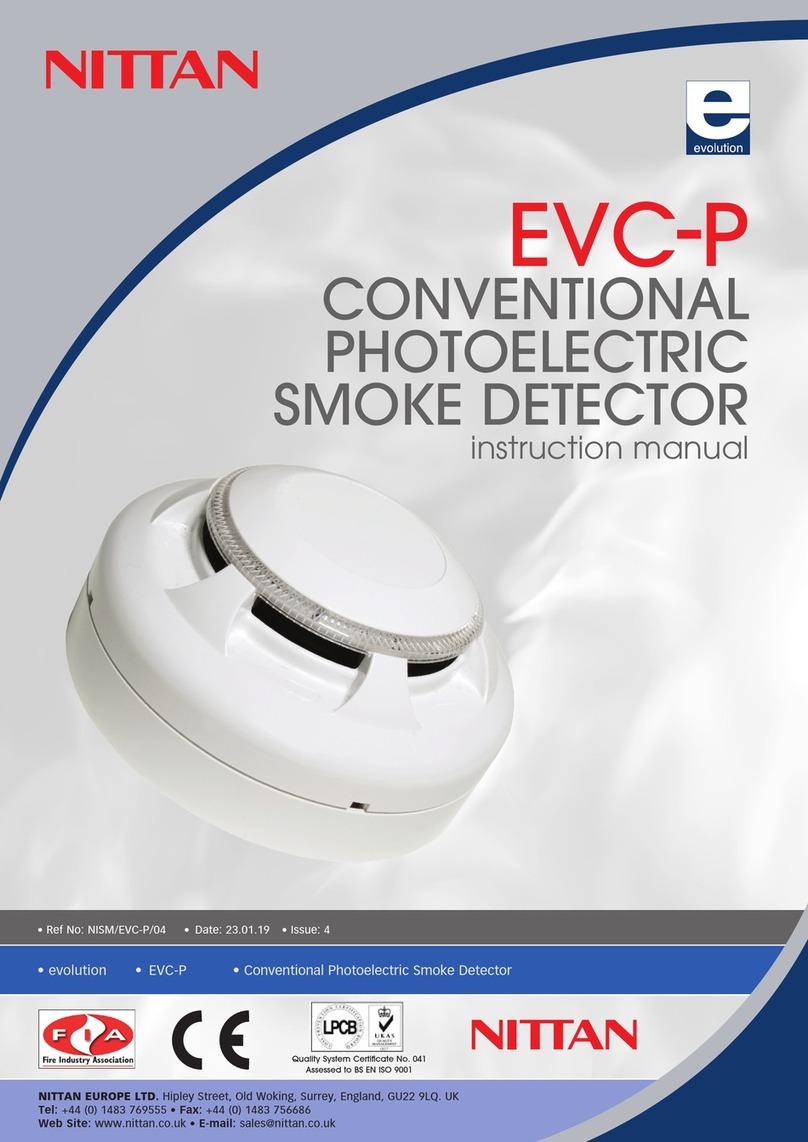
Nittan
Nittan EVC-P User manual
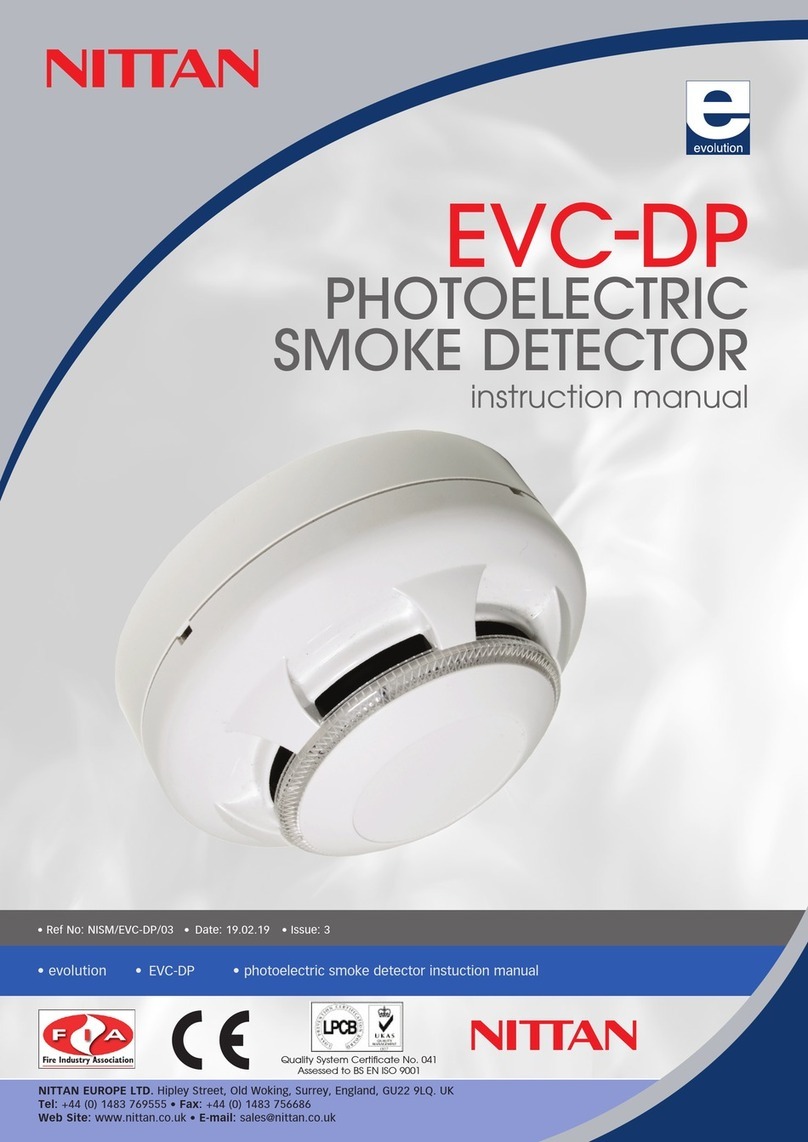
Nittan
Nittan Evolution EVC-DP User manual
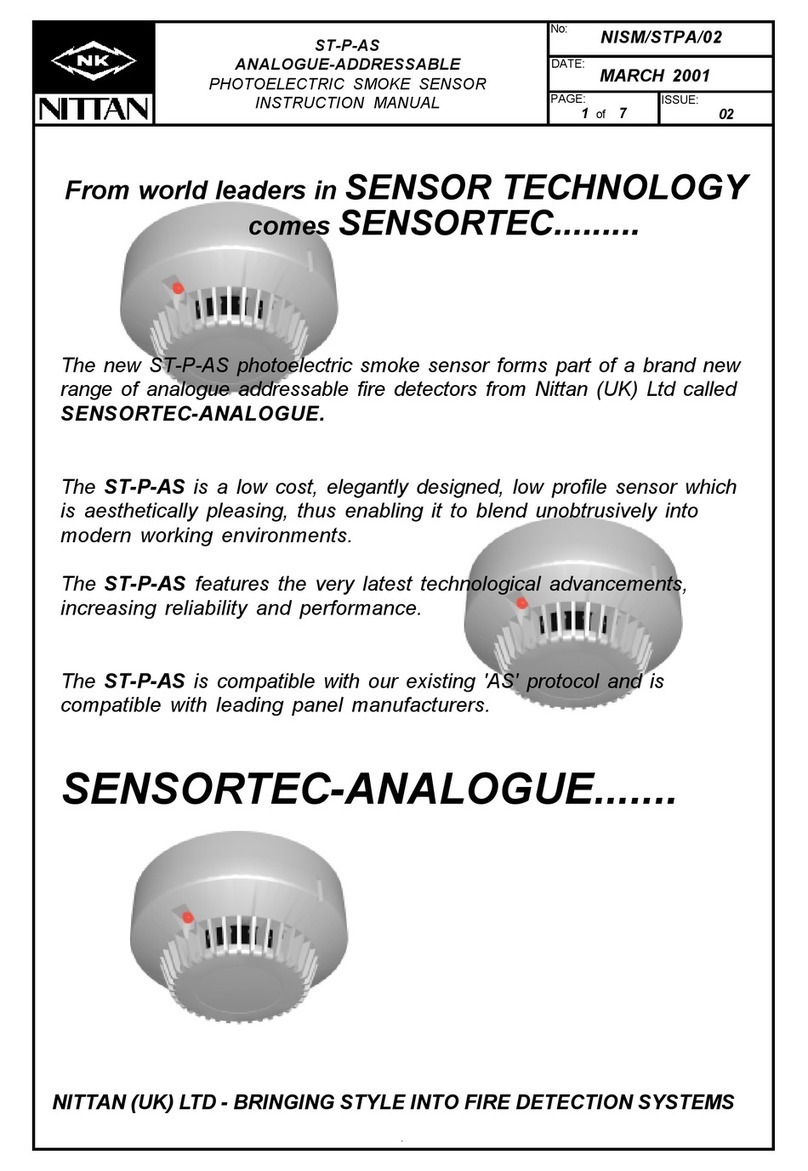
Nittan
Nittan ST-P-AS User manual
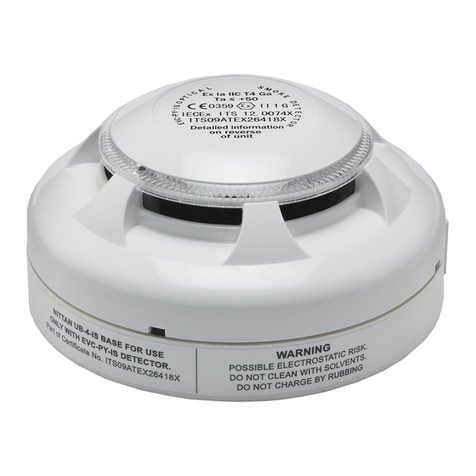
Nittan
Nittan evolution EVC-P User manual
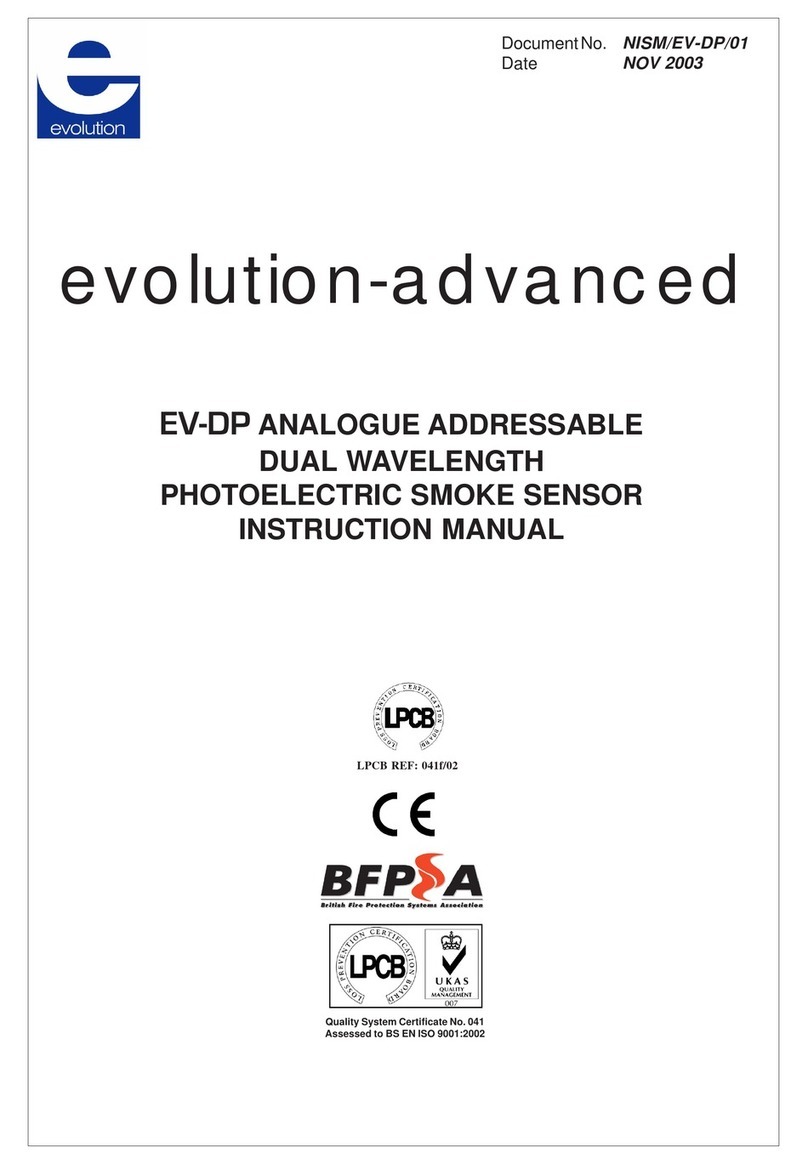
Nittan
Nittan Evolution-Advanced EV-DP User manual
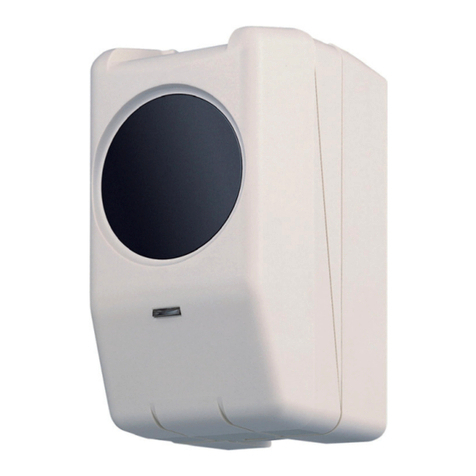
Nittan
Nittan CKLD-KPT2 User manual
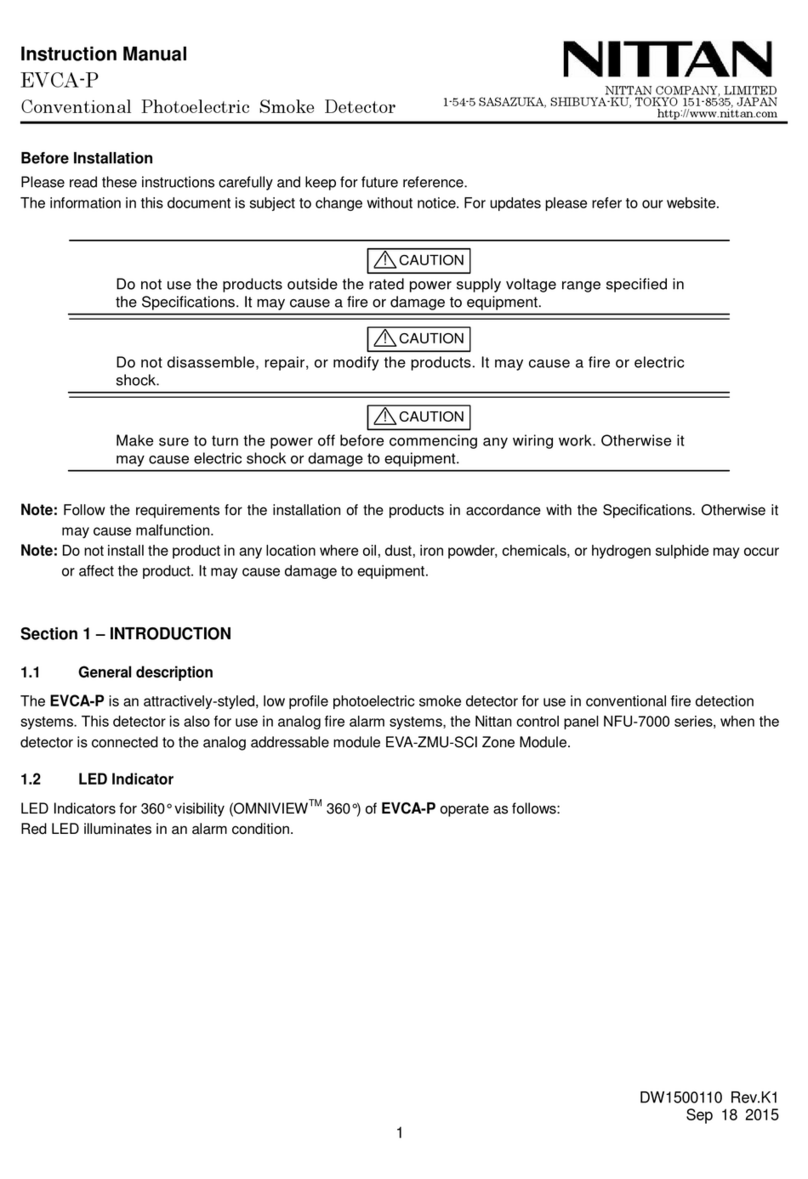
Nittan
Nittan EVCA-P User manual
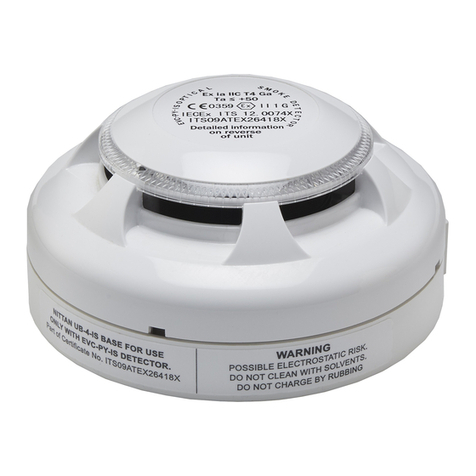
Nittan
Nittan EVA-PYH User manual
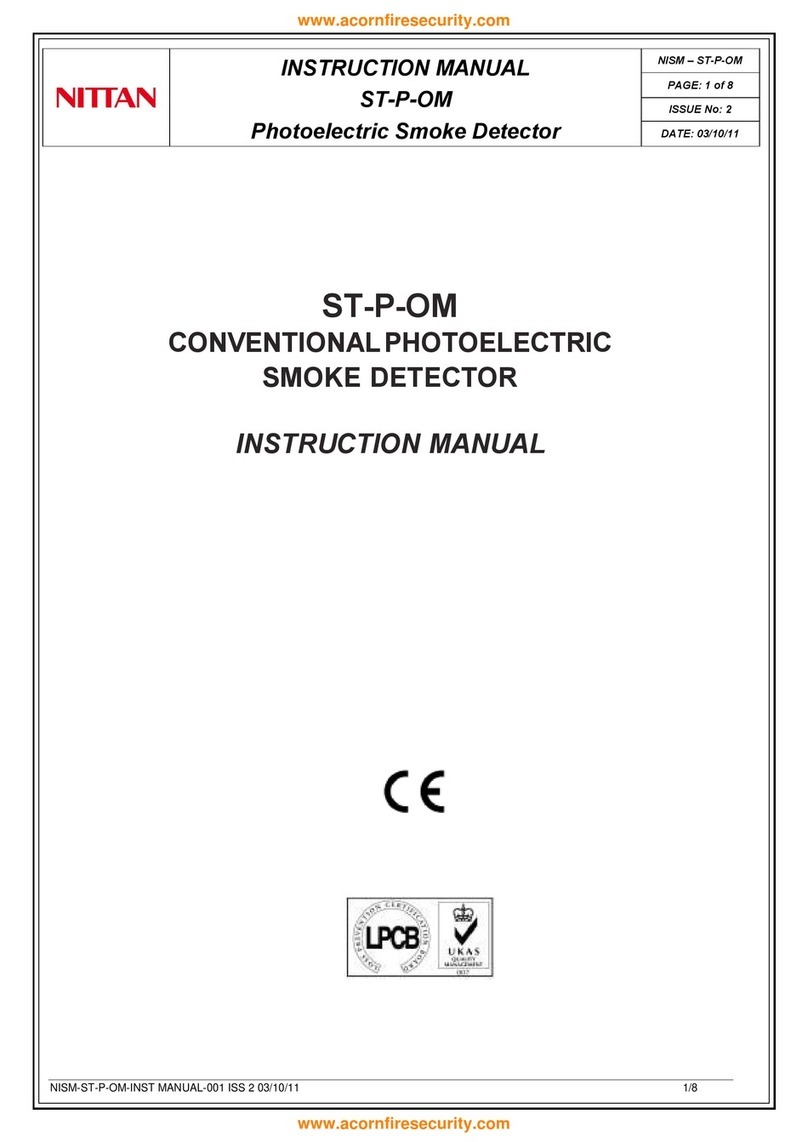
Nittan
Nittan ST-P-OM User manual
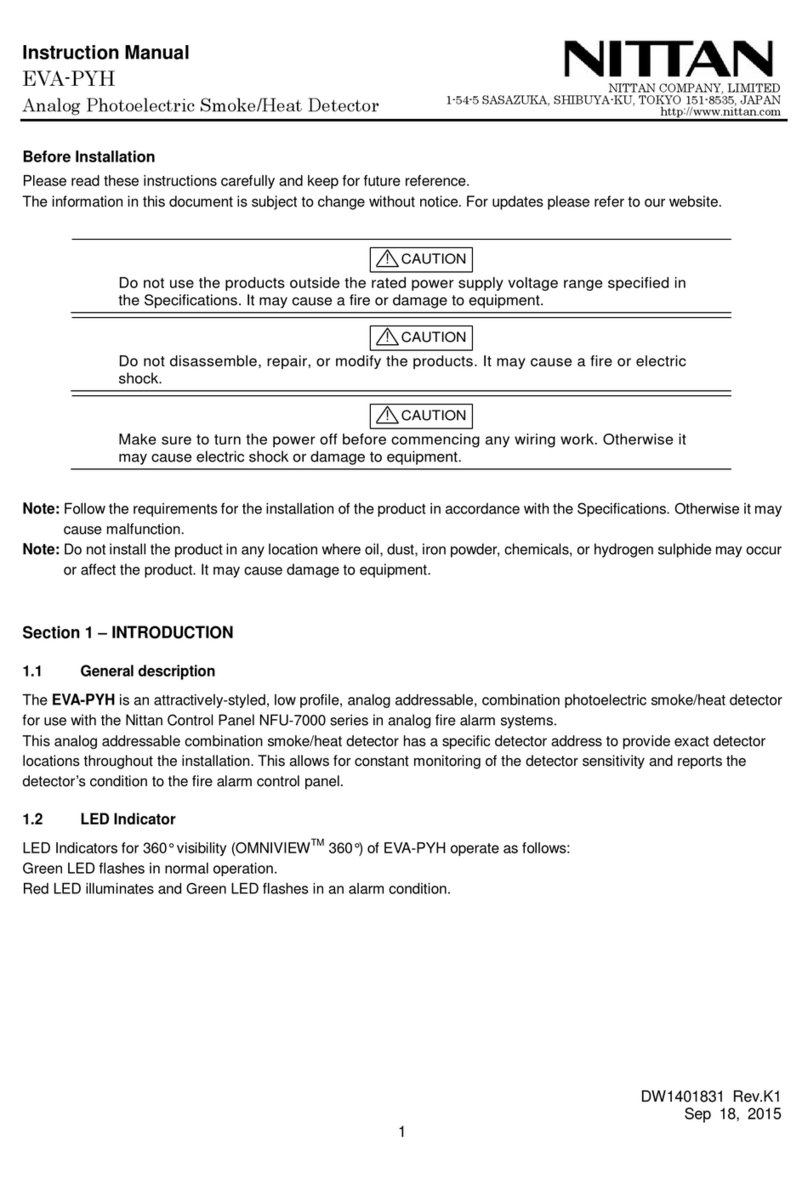
Nittan
Nittan EVA-PYH User manual
Popular Smoke Alarm manuals by other brands

FireAngel
FireAngel Thermoptek ST-622 user manual
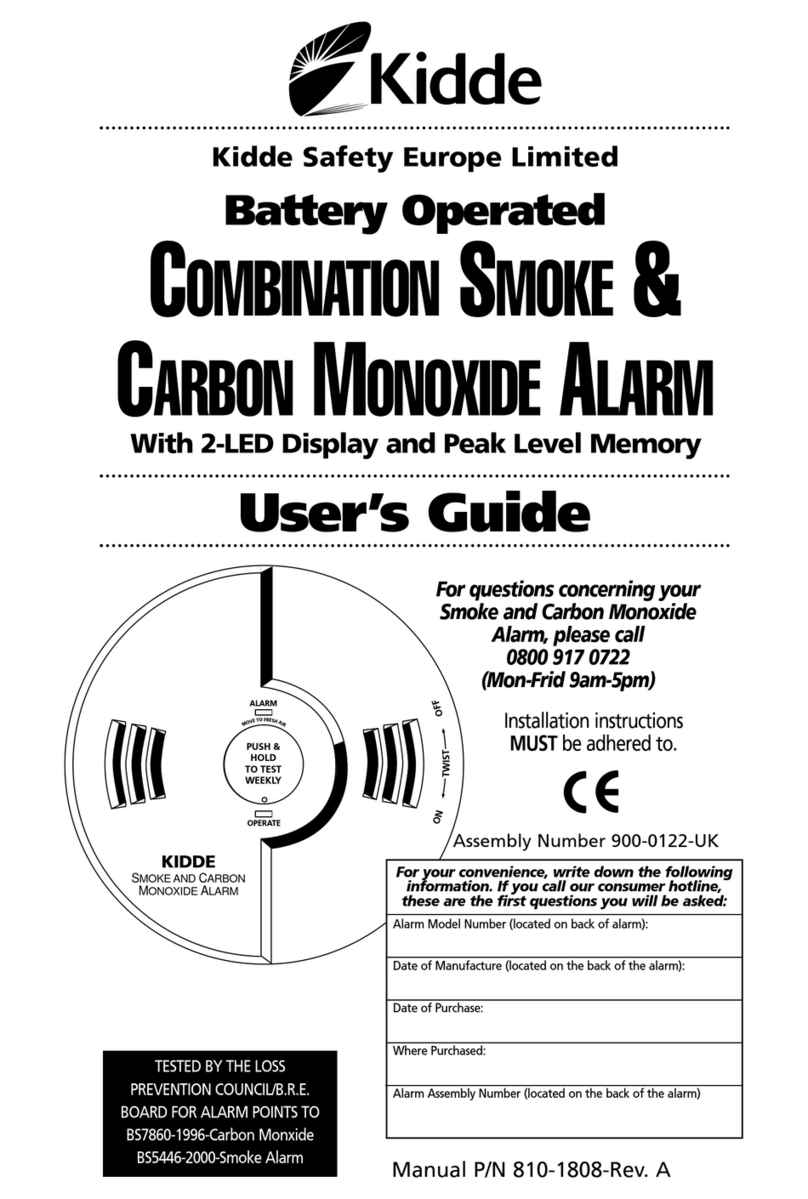
Kidde
Kidde 900-0122-UK user guide
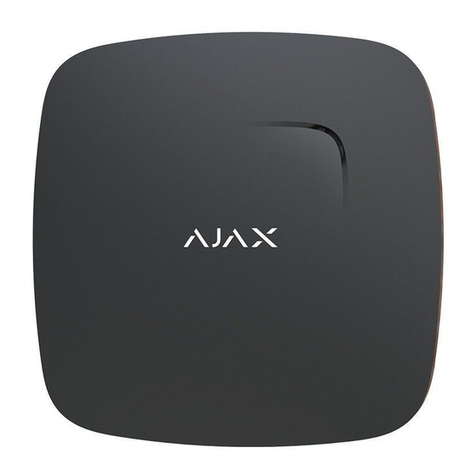
AJAX
AJAX FireProtect Plus quick start guide

Hochiki America
Hochiki America SPB-24N Installation instruction
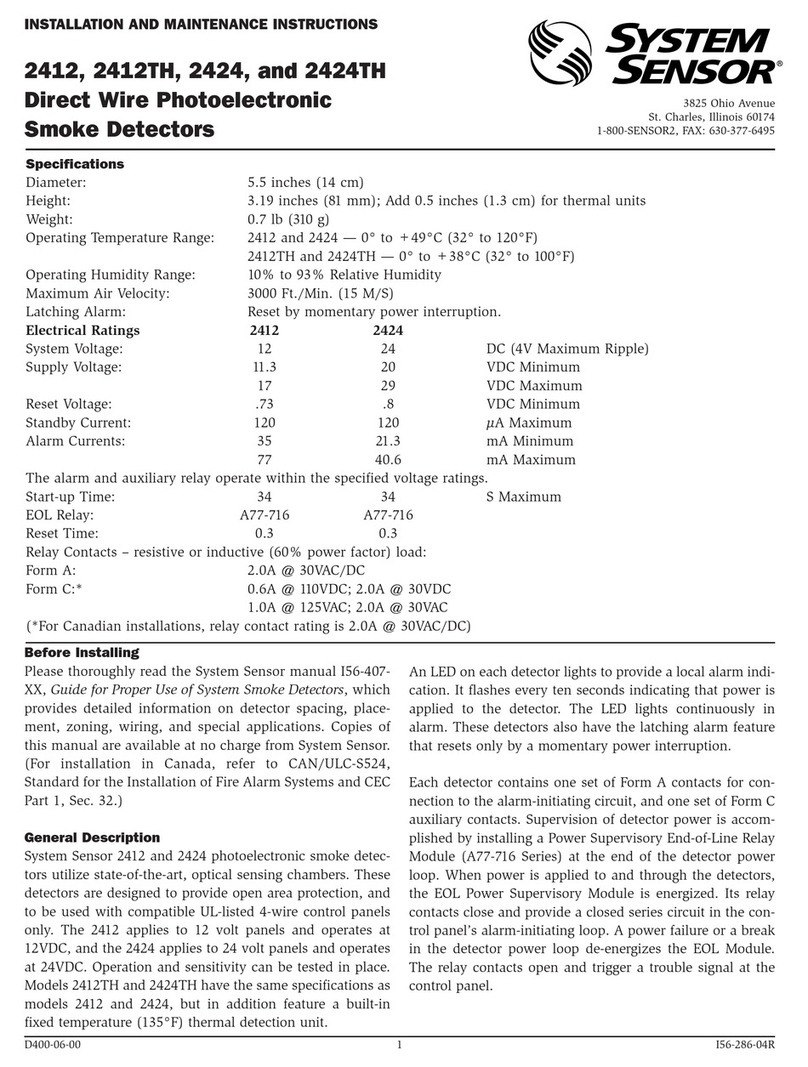
System Sensor
System Sensor 2412 Installation and maintenance instructions

Simplex
Simplex 4099-9004 quick start guide
